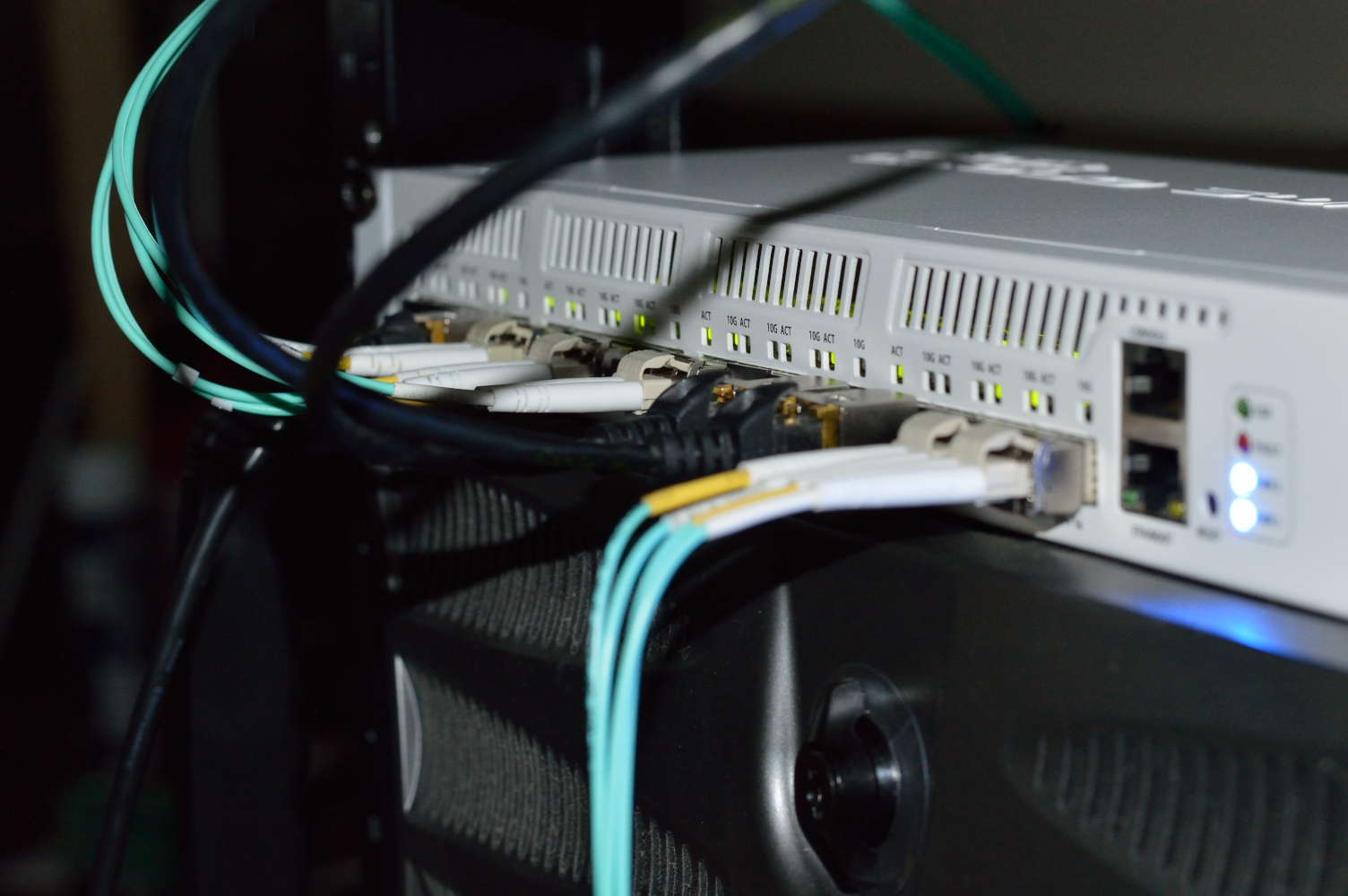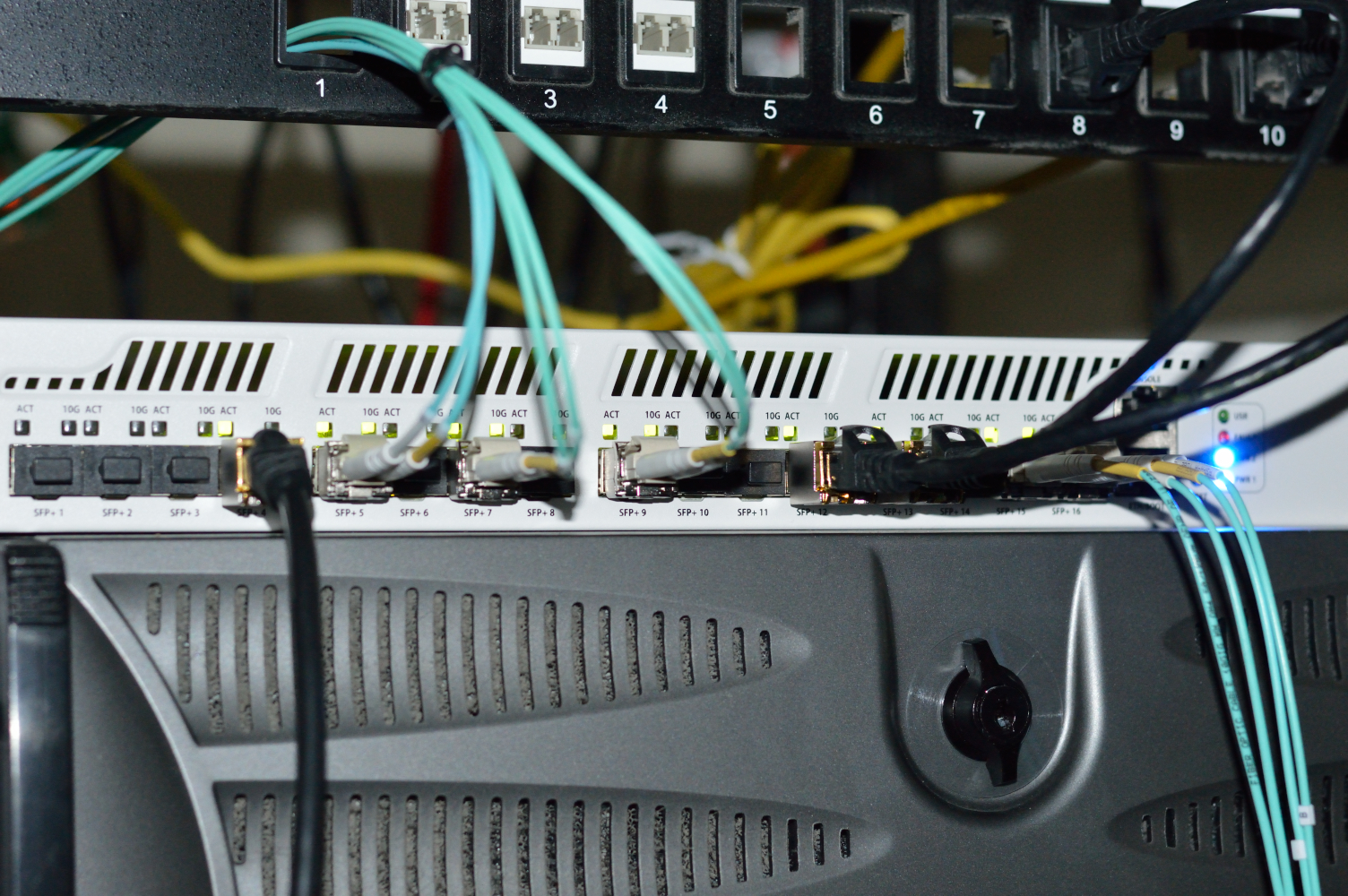- 10 gigabit (10Gb) home network – Part I
- 10 gigabit (10Gb) home network – Part II
- Again, Amazon?
- 10 gigabit (10Gb) home network – Zone 1 switch
- 10 gigabit (10Gb) home network – Zone 2 switch – Part 1
- 10 gigabit (10Gb) home network – Zone 2 switch – Part 2
- 10Gb home network – Retrospective
- Quanta LB6M
- 10 gigabit home network – Summary
- Revisiting the Quanta LB6M
- MikroTik CRS317 10GbE switch
- MikroTik CSS610
- Quieting the MikroTik CRS317
- Goodbye, MikroTik
- Troubleshooting 2.5Gb power over Ethernet
For the last two years I’ve been using the Quanta LB6M as the backbone of my home network. A 24 port SFP+ switch with four (4) GbE RJ45 ports connecting two Gigabit switches and my Internet router. So everything came to the LB6M and was routed accordingly.

It works quite well, too. Provided you can live with the noise. The first thing I did when I received it, before putting it into service, was swap the rear 40mm fans on the fan sled with much quieter fans. This quieted down the system, but it also caused the switch to run very hot. Two things helped me counter this: I cut out the fan grills on the fan sled, and did some maintenance on the thermal paste inside it. And I also had a fan blowing onto the underside.
But replacing the fans didn’t entirely eliminate the noise since I was not going to replace the fans in the power supplies. I’d been looking around for better options since.
And that’s where this comes in: the MikroTik CRS317. (Buy it at Amazon or EuroDK) It comes at a slight premium. 400 USD MSRP compared to the about 240 USD I paid for the Quanta LB6M in January 2017. Though you can get it for less through different suppliers. Just pay attention to shipping costs.

And I jumped for it for three reasons:
- Passively cooled. Mostly. It has two 40mm fans, which should not be running all the time.
- SFP+. It should be drop-in to my current setup.
- GbE SFP module support. And it should just be plug and play.
That third point means this switch will be replacing two: the LB6M and a TP-Link 8-port GbE switch. Getting the LB6M working with GbE SFP modules is… it’s definitely NOT just plug and play and requires flashing a different firmware to the switch to get it to work. No thanks.
SFP modules
I’ve had no issues with Fiber Store’s 10GBase-SR SFP+ modules. They happily worked with the Quanta LB6M, and I fully expected them to work with the MikroTik switch. I returned to Fiber Store for their SFP RJ-45 modules (Generic), since they were also about 30+% less expensive than any price I could find for MikroTik’s SFP module. I ordered one for each GbE connection I had to the LB6M.
Using SFP modules to consolidate GbE connections is only cost and value-effective if you’re consolidating a few. Four or five at most. Beyond that, and it’s a better value acquiring a GbE switch with a 10GbE uplink to avoid having a significant number of 10GbE ports occupied by GbE connections.
Initial setup and SwOS
The initial setup was interesting. I’ll spare the details here, but getting it swapped over to SwOS and away from RouterOS was a little cumbersome at first.
Only because I discovered something the online documentation omits as of this writing: after changing it over to boot to SwOS, shutdown the switch (System->Shutdown) and unplug it. Don’t just simply reboot it. Then when you plug it back in, it should boot into SwOS and everything should work.
SwOS by default will automatically attempt to acquire an IP address via DHCP and only fall back to its default 192.168.88.1 if it’s unable to. This means you should be able to switch it over to SwOS, shut it down, and then add it into your network like any other switch. The IP address determines how easily you can access the web UI, and is a good check on whether the switch is configured properly.
Racking it up
I initially thought I wouldn’t be able to pull the TP-Link switch for lack of SFP modules. But I realized later that the IP-KVM and the UPS SNMP module are the only two devices connected to it. The SNMP module doesn’t need a lot of bandwidth. It’d probably be perfectly happy on a 10Mb connection. The IP-KVM? It really needs the GbE connection with as little contention as possible, so it’s getting hooked into the 10GbE switch.
So I connected the SNMP directly to the router, and connected the KVM to the 10GbE switch, allowing me to pull the GbE switch from the rack. If I really feel like doing so, I can order another SFP module to connect the SNMP into the 10GbE switch.
All the other 10GbE connections just worked with the Fiber Store SFP+ modules I’d been using. One thing I also realized in hindsight: I likely could’ve used the ETH/BOOT port (the RJ45 port with lights) as the uplink to the router, opening up a connection for the SNMP module. I’ll look at that later, though. For now, everything works.


Impressions and comments
This switch is very, very quiet compared to the rest of the hardware in the rack. The Quanta switch easily overpowered everything else on noise, even with the quieter fans and just one power supply plugged in. The Mikrotik switch, however, is easily overpowered by the NAS and virtualization server. This is a nice change. Unplugging the Quanta switch to pull it out of the rack… it’s amazing what you become accustomed to over time.
The MikroTik CRS317 is also very lightweight. It’s about the size and weight of a 1U GbE switch, like a 16-port TrendNet switch I have in my den.
So it’s compact, quiet, lightweight, and supports up to (16) 10GbE SFP+ or GbE SFP connections. All brand new it’s significantly less than the cost of a brand new RJ45 10GbE switch. And it’s easy to get set up for SwOS, once you account for the one slight detail I provided above.
This is the much, much better option in my opinion over the Quanta LB6M. The noise aside, the fact the LB6M doesn’t support GbE SFP out of the box means you can’t really use that switch to its full potential in a smaller setup. But it was never meant for a smaller setup. That it has 24 ports shows this. That it’s louder than a 747 during take-off with the stock fans also shows this. It’s meant to be in a server room or networking closet.
The 16 ports on the MikroTik CRS317 shows it’s not exactly meant for a “small” setup either. But it’s a hell of lot better suited to a setup like mine than the Quanta. And it’s working as expected.
You must be logged in to post a comment.